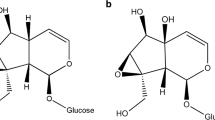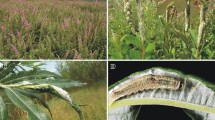Abstract
Trabala vishnou gigantina Yang (Lepidoptera: Lasiocampidae) is a major pest that damages the sea-buckthorn, Hippophae rhamnoides. We observed and compared the feeding preferences of T. vishnou gigantina larvae on six sympatric plant species in a two-choice test. We also compared T. vishnou gigantina fitness, as measured by the following variables: larvae weight, developmental period, pupae versus adult weight, longevity, and fecundity rates. Between host and non-host plants, larvae showed a strong preference for their natural host (sea-buckthorn), followed by apricot, poplar, and willow. Caragana and locust were the least preferred plants when the natural host plant was not present. Larvae reared on sea-buckthorn possessed greater pre-pupal weight, had lower mortality, and developed more quickly into heavier pupae than either poplar-raised or willow-raised larvae. Fecundity was highest on sea-buckthorn, second highest on apricot, and lowest on poplar. Longevity (of both females and males) was not significantly different across plant species. These results clearly demonstrate that T. vishnou gigantina larvae are able to distinguish between host versus non-host plants, and that their preference translates to increased fitness. Possible, non-mutually exclusive explanations for observed preference and fitness differences include variation in required nutritional content across plant species or the presence of plant traits (morphological features or chemical metabolites) that negatively affect larval development. While the exact mechanisms are unknown, these data may be useful for the development of appropriate counter-measures to the damage caused by T. vishnou gigantina on sea-buckthorn.






Similar content being viewed by others
References
Awmack CS, Leather SR (2002) Host plant quality and fecundity in herbivorous insects. Annu Rev Entomol 47:817–844. doi:10.1146/annurev.ento.47.091201.145300
Bao H (2015) Response of growth characteristics of Prunus ansu from different provenances in seedling stage to drought stress. Inn Mong For Sci Technol 41:5–8
Berdegue M, Trumble JT (1996) Effects of plant chemical extracts and physical characteristics of Apium graveolens and Chenopodium murale on host choice by Spodoptera exigua larvae. Entomol Exp Appl 78:253–262. doi:10.1111/j.1570-7458.1996.tb00789.x
Bernays EA, Chapman RF (1994) Host-plant selection by phytophagous insects. Springer, New York
Bernays EA, Jarzembowski EA, Malcolm SB (1991) Evolution of insect morphology in relation to plants [and discussion. Philos Trans R Soc B 333:257–264. doi:10.1098/rstb.1991.0075
Cahenzli F, Erhardt A (2013) Transgenerational acclimatization in an herbivore-host plant relationship. Proc R Soc B 280:20122856. doi:10.1098/rspb.2012.2856
Chapman RF (1998) The insects: structure and function, 4th edn. Cambridge University Press, Cambridge ISBN: 0521578906
D’Costa L, Simmonds MSJ, Straw N, Castagneyrol B, Koricheva J (2014) Leaf traits influencing oviposition preference and larval performance of Cameraria ohridella on native and novel host plants. Entomol Exp Appl 152:157–164. doi:10.1111/eea.12211
Dethier VG (1954) Evolution of feeding preferences in phytophagous insects. Evolution 8:33–54
Fahey JW, Zalcmann AT, Talalay P (2001) The chemical diversity and distribution of glucosinolates and isothiocyanates among plants. Phytochemistry 56:5–51. doi:10.1016/S0031-9422(00)00316-2
Foster SP, Howard AJ (1999) Adult female and neonate larval plant preferences of the generalist herbivore, Epiphyas postvittana. Entomol Exp Appl 92:53–62. doi:10.1046/j.1570-7458.1999.00524.x
Friberg M, Wiklund C (2009) Host plant preference and performance of the sibling species of butterflies Leptidea sinapis and Leptidea reali: a test of the trade-off hypothesis for food specialisation. Oecologia 159:127–137. doi:10.1007/s00442-008-1206-8
Fuentes JE, Yates LR (1994) Host nutritional-value in larval feeding preference of Ormiscodes socialis (Feisthammel) (Lepidoptera, Saturniidae) in Chile. Rev Chil Hist Nat 67:27–33
Gamberale-Stille G, Söderlind L, Janz N, Nylin S (2014) Host plant choice in the comma butterfly—larval choosiness may ameliorate effects of indiscriminate oviposition. Insect Sci 21:499–506. doi:10.1111/1744-7917.12059
Henniges-Janssen K, Heckel DG, Groot AT (2014) Preference of diamondback moth larvae for novel and original host plant after host range expansion. Insects 5:793–804. doi:10.3390/insects5040793
Hillesheim E, Stearns SC (1992) Correlated responses in life-history traits to artificial selection for body weight in Drosophila melanogaster. Evolution 46:745–752. doi:10.2307/2409642
Itoyama K, Kawahira Y, Murata M, Tojo S (1999) Fluctuations of some characteristics in the common cutworm, Spodoptera litura (Lepidoptera: Noctuidae) reared under different diets. Appl Entomol Zool 34:315–321. doi:10.1303/aez.34.315
Janz N, Nylin S, Wedell N (1994) Host plant utilization in the comma butterfly: sources of variation and evolutionary implications. Oecologia 99:132–140. doi:10.1007/BF00317093
Liu YJ, Wu CS (2006) Fauna sinica insecta, vol. 47, 1st edn. Science Press, Beijing ISBN: 7-03-016877-1
Liu YH, Zhang YQ, Yan XF, Zong DL, Zong SX, Luo YQ (2013) Damage of Trabala vishnou gigantina (Lepidoptera: Lasiocampidae) to the sea-buckthorn forest and its biological characteristic. Plant Prot 39:147–152. doi:10.3969/j.isn.0529 1542.2013.02.030
Liu RT, Chai YQ, XU K, Yang MX, Zhu F (2014) Seasonal changes of ground vegetation characteristics under artificial Caragana intermedia plantations with age in desert steppe. Acta Ecol Sin 34:500–508. doi:10.5846/stxb201204040468
Loader C, Damman H (1991) Nitrogen content of food plants and vulnerability of Pieris rapae to natural enemies. Ecology 72:1586–1590. doi:10.2307/1940958
Luo YQ, Lu CK, Xu ZC (2003) Control strategies on a new serious forest pest insect-sea buckthorn carpenter worm, Holcocerus hippophaecolus. For Pest Dis 22:25–28. doi:10.3969/j.issn.1671-0886.2003.05.010
Mondy N, Charrier B, Fermaud M, Pracros P, Corio-Costet M-F (1998). Mutualism between a phytopathogenic fungus (Botrytis cinerea) and a vineyard pest (Lobesia botrana). Positive effects on insect development and oviposition behaviour. Cr. Acad. Sci. III-Vie 321:665–671. doi:10.1016/S0764-4469(98)80006-1
Naseri B, Fathipour Y, Moharramipour S, Hosseininaveh V (2009) Comparative life history and fecundity of Helicoverpa armigera (Hubner) (Lepidoptera: Noctuidae) on different soybean varieties. Entomol Sci 12:147–154. doi:10.1111/j.1479-8298.2009.00310.x
Niu YQ, Sun YX, Liu TX (2014) Development and reproductive potential of diamondback moth (Lepidoptera: Plutellidae) on selected wild crucifer species. Environ Entomol 43:69–74. doi:10.1603/EN13206
Otte D (1975) Plant preference and plant succession. Oecologia 18:129–144. doi:10.1007/BF00348094
Pappers SM, Van der Velde G, Ouborg JN (2002) Host preference and larval performance suggest host race formation in Galerucella nymphaeae. Oecologia 130:433–440. doi:10.1007/s00442-001-0822-3
Partridge L, Fowler K (1993) Responses and correlated responses to artificial selection on thorax length in Drosophila melanogaster. Evolution 47:213–226. doi:10.2307/2410130
Prager SM, Esquivel I, Trumble JT (2014) Factors influencing host plant choice and larval performance in Bactericera cockerelli. PLOS One 9:e94047. doi:10.1371/journal.pone.0094047
Rank NE (1992) Host plant preference based on salicylate chemistry in a willow leaf beetle (Chrysomela aeneicollis. Oecologia 90:95–101. doi:10.1007/BF00317814
Rather AH, Azim MN (2009) Feeding response in Pieris brassicae larvae to host/non-host plants. World J Agric Sci 5:143–145 http://www.idosi.org/wjas/wjas5(2)2.pdf
Razmjou J, Naseri B, Hemati S (2014) Comparative performance of the cotton bollworm, Helicoverpa armigera (Hübner) (Lepidoptera: Noctuidae) on various host plants. J Pest Sci 87:29–37. doi:10.1007/s10340-013-0515-9
Roden DB, Miller JR, Simmons GA (1992) Visual stimuli influencing orientation by larval gypsy moth, Lymantria dispar (L. Can Entomol 124:287–304
Rodrigues D, Freitas AV (2013) Contrasting egg and larval performances help explain polyphagy in a florivorous butterfly. Arthropod Plant Interact 7:159–167. doi:10.1007/s11829-012-9230-3
Rodrigues D, Moreira GRP (1999) Feeding preference of Heliconius erato (Lep.: Nymphalidae) in relation to leaf age and consequences for larval performance. J Lepid Soc 53:108–113. doi:10.1590/S0101-81752005000100006
Saeed R, Sayyed AH, Shad SA, Zaka SM (2010) Effect of different host plants on the fitness of diamond-back moth, Plutella xylostella (Lepidoptera: Plutellidae. Crop Prot 29:178–182. doi:10.1016/j.cropro.2009.09.012
Scboonhoven LM, Jermy T, Van Loon JJA (1998) Insect-plant biology: From physiology to evolution, 1st edn. Chapman & Hall, London ISBN: 0412804808
Shikano I, Akhtar Y, Isman MB (2010) Relationship between adult and larval host plant selection and larval performance in the generalist moth, Trichoplusia ni. Arthropod Plant Interact 4:197–205. doi:10.1007/s11829-010-9100-9
Silva AK, Gonçalves GL, Moreira GRP (2014) Larval feeding choices in heliconians: induced preferences are not constrained by performance and host plant phylogeny. Anim Behav 89:155–162. doi:10.1016/j.anbehav.2013.12.027
Thorsteinson AJ (1953) The role of host selection in the ecology of phytophagous insects. Can Entomol 85:276–282. doi:10.4039/Ent85276-8
Tikkanen OP, Lyytikäinen-Saarenmaa P (2002) Adaptation of a generalist moth, Operophtera brumata, to variable budburst phenology of host plants. Entomol Exp Appl 103:123–133. doi:10.1046/j.1570-7458.2002.00966.x
Tikkanen OP, Niemelä P, Keränen J (2000) Growth and development of a generalist insect herbivore, Operophtera brumata, on original and alternative host plants. Oecologia 122:529–536. doi:10.1007/s004420050976
Uechi N, Yukawa J (2006) Host range and life history of Asphondylia sphaera (Diptera: Cecidomyiidae): use of short-term alternate hosts. Ann Entomol Soc Am 99:1165–1171. doi:10.1603/0013-8746(2006)99[1165:HRALHO]2.0.CO;2
Uyi OO, Hill MP, Zachariades C (2014) Variation in host plant has no effect on the performance and fitness-related traits of the specialist herbivore Pareuchaetes insulata. Entomol Exp Appl 153:64–75. doi:10.1111/eea.12229
Wang GC, Wu Y, Gui SY (1987) Four nuclear polyhedrosis viruses of poplar and willow insect pests newly discovered in China. Sci. Silvae Sinica 22:90–93
Wang SF, Zong SX, Zhang JT, Qi Z, Zhang YF (2012) Biological characteristics of the Trabala vishnou gigantina Yang (Lepidoptera: Lasiocampidae). J Shanxi Agric U Nat Sci Ed 32:235–239
Acknowledgments
The study was sponsored by the Fundamental Research Funds for the Central Universities (Grant No. YX2015-09), Beijing Natural Science Foundation (Grant No. 6142015), Beijing Young Elite Project (Grant No. 2013D009046000002), Special Fund for Forest Scientific Research in the Public Welfare (Grant No. 201404401), and the Twelfth Five-year National Science and Technology Support Program of China (Grant No. 2012BAD19B07).
Author information
Authors and Affiliations
Corresponding authors
Ethics declarations
Conflict of Interest
The authors declare that they have no conflict of interest.
Rights and permissions
About this article
Cite this article
Wen, DM., Yu, LF., Liu, YH. et al. Trabala Vishnou Gigantina Yang (Lepidoptera: Lasiocampidae) Larval Fitness on six Sympatric Plant Species in Sea-Buckthorn Forest. J Insect Behav 29, 591–604 (2016). https://doi.org/10.1007/s10905-016-9582-0
Revised:
Accepted:
Published:
Issue Date:
DOI: https://doi.org/10.1007/s10905-016-9582-0




